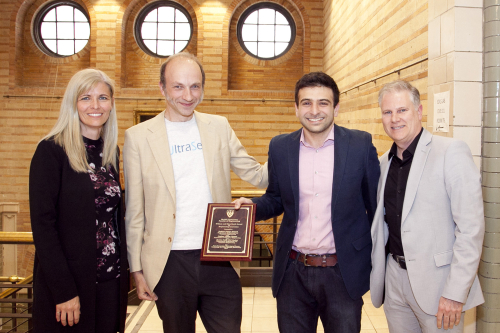Winners of the 2018-2019 William and Rhea Seath Awards Competition
Presented by Associate Dean, Research and Innovation Benoit Boulet

(left to right) Professor Vivian Yargeau (Chemical Engineering), Professor Thomas Szkopek and Ibrahim Fakih, PhD candidate (both Electrical and Computer Engineering) for “Next-Generation Hydrological Sensor Technology for Water Quality Monitoring”
Executive summary:
Water is a natural resource essential to the global biosphere, and no less important to the well-being of a nation's citizens. Despite its importance, water quality is insufficiently measured in space and time due to cost, practicality and overall feasibility. Deficiencies in water quality monitoring can be overcome by increasing the accessibility of ion sensing tools. We have developed inexpensive graphene ion sensing field effect transistors (ISFETs) with very low detection limits that can measure water quality in real-time. Our invention can potentially fill an important void in water quality monitoring technology. With this award we will validate graphene ISFETs by testing them in the field and integrating them with the Internet of Things (IoT).

(left to right) Hamed Rafezi, PhD candidate and Professor Ferri Hassani (both Mining and Materials Engineering) for “Tricone Bit Wear Monitoring and Failure Prediction”
Executive summary:
The mining industry is moving toward automation and autonomous machinery for increasing the efficiency and precision in production. A successful automated blasthole drilling condition monitoring is a necessary component of this journey. Drilling and blasting (Appendix – figure 1 and 2) are two preliminary tasks in large surface mining operations and constitute more than 15% of the total operational costs. Bit wear and subsequent bit failure create remarkable delays and costs. The detached bit parts after the failure must be removed from the hole to avoid damage to the rock crusher equipment. In addition, fully autonomous drilling would not be achievable without a machine sensing system for recognizing when the drill bit is worn and requires replacing. Our patent-pending system, offers a solution to monitor the bit wear level in real-time and to predict the catastrophic failure. The system relies on signals analysis and an artificial intelligence model trained by full-scale drilling data gathered in mining operations in the past phases. The proposed application aims to cover the costs to build a stand-alone prototype of our system.
